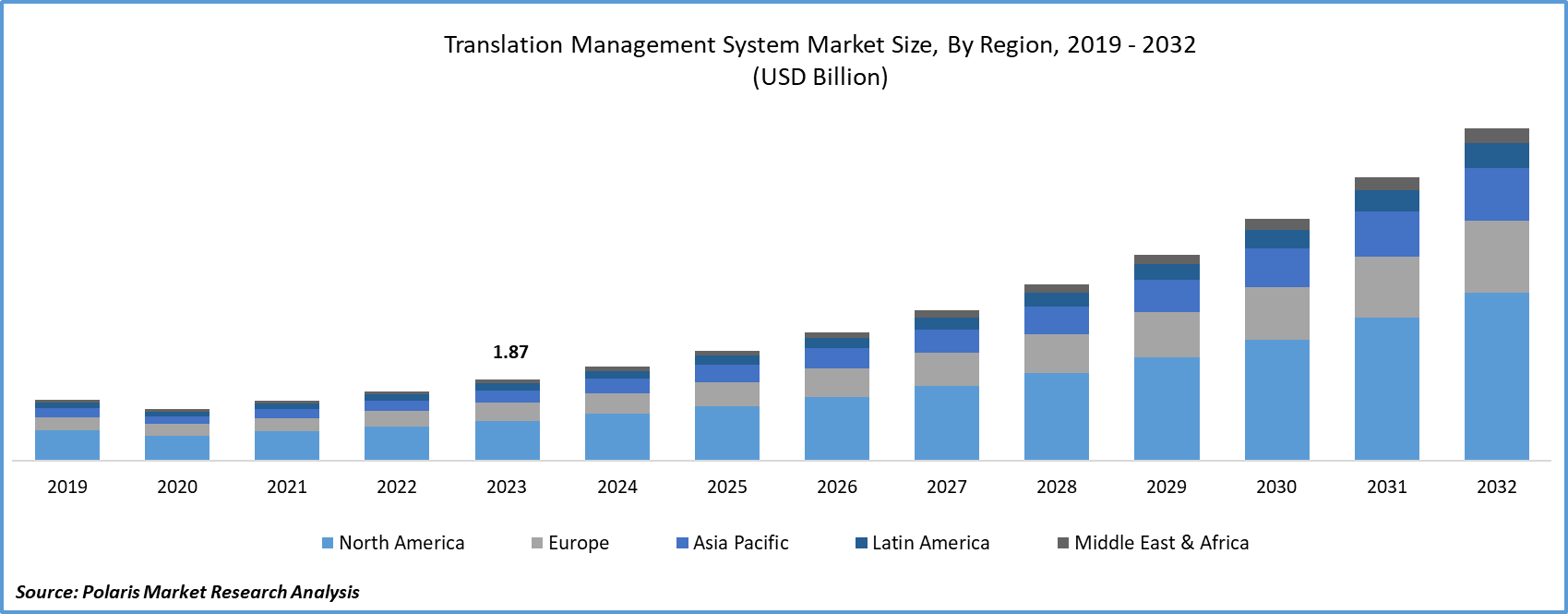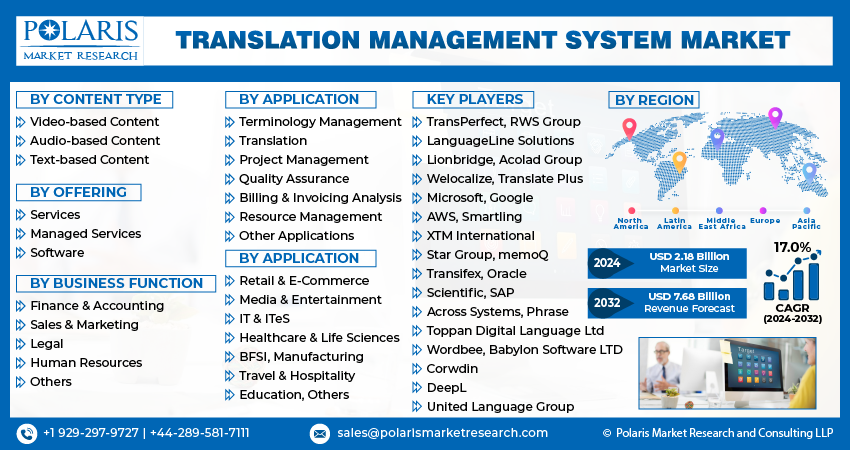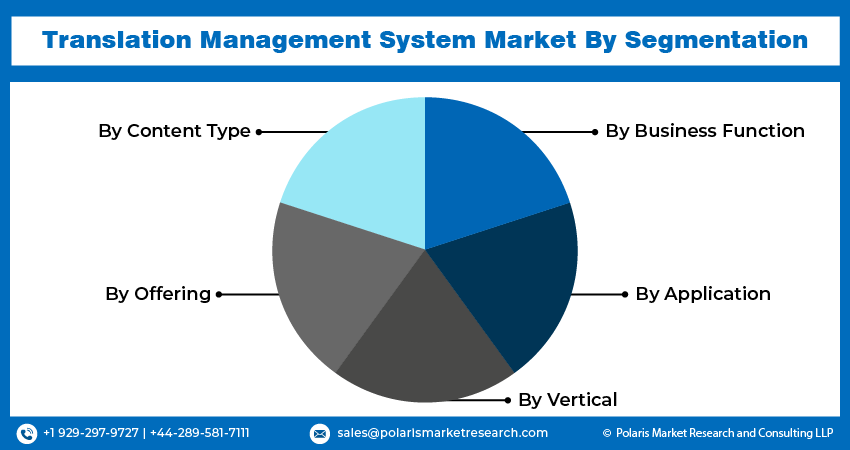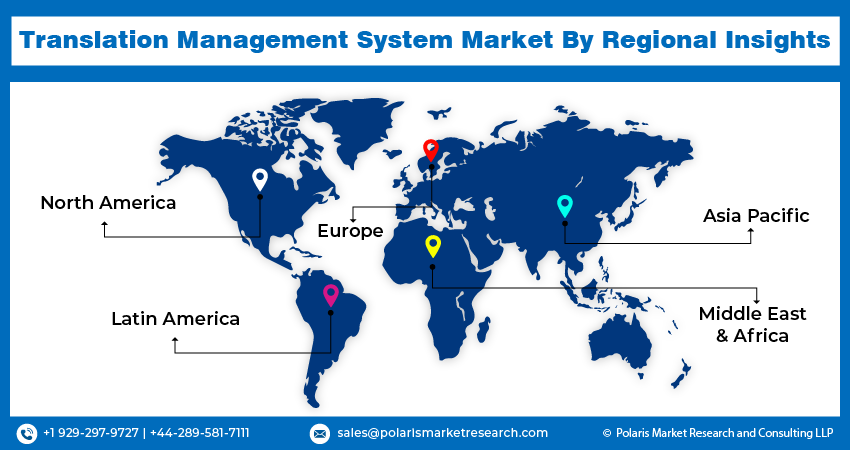
Translation Management System Market Share, Size, Trends, Industry Analysis Report
By Content Type (Video-based Content, Audio-based Content, Text-based Content); By Offering; By Business Function; By Application; By Vertical; By Region; Segment Forecast, 2024- 2032
- Published Date:Mar-2024
- Pages: 118
- Format: PDF
- Report ID: PM4646
- Base Year: 2023
- Historical Data: 2019-2022
Report Outlook
Translation Management System Market size was valued at USD 1.87 billion in 2023. The market is anticipated to grow from USD 2.18 billion in 2024 to USD 7.68 billion by 2032, exhibiting a CAGR of 17.0% during the forecast period
Translation Management System Market Overview
The growth in the Translation Management Systems (TMS) market size is propelled by a convergence of factors highlighting the evolving nature of global business operations. A significant catalyst for this surge is the relentless force of globalization, as businesses strive to expand their reach and establish a global presence. In this pursuit, the proliferation of expanding the scope and digital content of cross-border operations has generated a pressing need for efficiency in translation solutions capable of overcoming barriers in language. TMS has emerged as a central player in addressing this demand, ensuring semantic consistency, fostering collaboration, and streamlining translation workflows for enterprises managing multilingual content.

To Understand More About this Research: Request a Free Sample Report
The growth of the Translation Management System market is intricately linked to the collaborative integration of businesses with advanced technologies, particularly Machine translations and Artificial Intelligence (AI). This collaboration enhances the speed and accuracy of translation processes, contributing to the overall efficiency of language management. The translation management system market trend reflects a broad industry shift where businesses are increasingly acknowledging the crucial role of proficient language management in attaining and maintaining global success. Consequently, the TMS market finds itself at the forefront of meeting the evolving needs of enterprises navigating the complexities of a globalized business landscape. The increasing adoption of TMS extends beyond addressing immediate challenges; it is a strategic move by businesses to fortify their global competitiveness. The revenue growth in the Translation Management System market growth signifies a fundamental shift in the perception of language management, with businesses acknowledging it as a critical component for achieving seamless international operations. TMS, with its capability to address the intricacies of multilingual content management, emerges as a key enabler for enterprises seeking to navigate the complexities of a globalized marketplace and establish a robust presence across borders.

Translation Management System Market Dynamics
Market Drivers
Globalization and Cross-Border Operations bolstering the growth of the Translation Management System market share.
The demand for effective language translation solutions is driven by the escalating trend of globalization among businesses and the widespread expansion of cross-border operations. As companies seek to establish a robust global presence, the need for clear and accurate communication across diverse linguistic landscapes becomes paramount. The intricacies of language barriers can pose significant challenges to international business operations, making Translation Management Systems (TMS) indispensable tools. TMS allows organizations to navigate and overcome language obstacles, ensuring that linguistic differences do not hinder communication. By facilitating seamless translation workflows, TMS plays a crucial role in fostering effective cross-border communication, enabling companies to engage with diverse markets and stakeholders on a global scale.
In the context of globalization, TMS serves as a strategic asset for businesses looking to transcend geographical boundaries and connect with a broader, international audience. As companies expand their operations into new regions, TMS becomes an essential component for managing multilingual content, ensuring consistency in messaging, and enhancing overall communication efficiency. The ability of TMS to streamline translation processes contributes to the success of cross-border endeavors by providing a scalable and adaptable solution that aligns with the evolving language requirements of global markets.
Market Restraints
The Complexity of Language Structures is Likely to Hamper the Growth of the Market
The varied and intricate structures inherent in different languages pose a considerable challenge for TMS platforms. Nuances, idioms, and the nuanced cultural context embedded in languages demand sophisticated linguistic capabilities for accurate translation. TMS solutions may encounter limitations in fully capturing these complexities, especially when dealing with languages that have intricate grammatical rules, contextual dependencies, or cultural subtleties. As a result, achieving a high level of precision and contextually accurate translations across all language pairs remains a persistent challenge for the TMS market.
Handling the intricacies of language structures is crucial for effective communication, particularly in industries where precision and context are paramount, such as legal or technical fields. TMS providers need to continuously enhance their linguistic algorithms and incorporate advancements in natural language processing to navigate the intricacies of diverse language structures better and deliver more accurate translations.
Report Segmentation
The market is primarily segmented based on content type, offering, business function, application, vertical, and region.
|
By Content Type |
By Offering |
By Business Function |
By Application |
By Vertical |
By Region |
|
|
|
|
|
|
To Understand the Scope of this Report: Speak to Analyst
Translation Management System Market Segmental Analysis
By Offering Analysis
In 2023, translation software is anticipated to secure the largest translation management system market outlook, primarily owing to its pivotal role in facilitating efficient and precise language translation. As businesses extend their global reach, there has been a notable surge in demand for automated translation tools embedded within Translation Management Systems (TMS) to streamline the management of multilingual content. The utilization of translation software empowers organizations to rapidly translate extensive volumes of text, thereby boosting productivity and minimizing manual efforts. The effectiveness and scalability inherent in translation software position it as a foundational element in TMS solutions, effectively addressing the escalating requirement for swift and dependable language translation in an increasingly interconnected global business landscape.
By Content Type Analysis
The forecast period is expected to witness a rapid surge in the growth of audio-based content, propelled by the increasing prevalence of audiobooks, multimedia content, and podcasts. As consumers increasingly embrace audio content for its accessibility and convenience, businesses find themselves compelled to translate and localize audio materials to reach broader audiences effectively. Translation Management Systems (TMS) play a crucial role in facilitating the translation of spoken content by seamlessly integrating with Automatic Speech Recognition (ASR) and Natural Language Processing (NLP) technologies, enabling accurate transcription followed by translation. For example, a global streaming platform might leverage TMS to translate and localize podcasts seamlessly, ensuring the preservation of linguistic and cultural nuances across diverse language markets. The escalating demand for the efficient and precise translation of audio content, driven by the growing popularity of auditory experiences, solidifies audio-based content as the fastest-growing segment by content type in the TMS market.

Translation Management System Market Regional Insights
The Asia Pacific Region Dominated the Global Market with the Largest Market Share in 2023
The economic growth and increasing globalization in the Asia-Pacific region have spurred businesses to expand their operations across various linguistic contexts. As companies establish their presence in multiple countries within the Asia-Pacific (APAC), there has been a significant upswing in the demand for Translation Management System (TMS) solutions to adeptly handle the intricacies of translating and localizing content for diverse audiences.
Both the Japanese and Chinese governments are actively backing language service providers (LSPs) and translator tools.

Competitive Landscape
The Translation Management System market player is fragmented and is anticipated to witness competition due to several players' presence. Major service providers in the market are constantly upgrading their technologies to stay ahead of the competition and to ensure efficiency, integrity, and safety. These players focus on partnership, product upgrades, and collaboration to gain a competitive edge over their peers and capture a significant market share.
Some of the major players operating in the global market include:
- TransPerfect
- RWS Group
- LanguageLine Solutions
- Lionbridge
- Acolad Group
- Welocalize
- Translate Plus
- Microsoft
- AWS
- Smartling
- XTM International
- Star Group
- memoQ
- Transifex
- Oracle
- Scientific
- SAP
- Across Systems
- Phrase
- Toppan Digital Language Ltd
- Wordbee
- Babylon Software LTD
- Corwdin
- DeepL
- United Language Group
Recent Developments
- In January 2024, In collaboration with Oracle, Bosch Brazil has joined forces to leverage the multilingual capabilities of Oracle Digital Assistant (ODA). This strategic partnership highlights the effectiveness of integrating cutting-edge technologies like artificial intelligence and customer service solutions. Bosch opted for ODA due to its adaptability, enabling the generation and comprehension of responses in various languages, along with its capability to produce speech in multiple languages.
- In January 2024, Acolad broadened its comprehensive array of solutions and technological offerings with the introduction of an artificial intelligence-powered solution known as AI voice-over. This innovative solution guarantees compelling synthetic voice-over and dubbing, merging cutting-edge speech synthesis technology with top-tier resources to deliver high-quality results.
- In January 2024, In collaboration with Microsoft, OneMeta joined forces to integrate its AI-powered translation and transcription Verbum service into Microsoft Teams. OneMeta's Verbum software, capable of translating and transcribing in over 140 languages, has achieved Microsoft IP Co-sell Ready Status through this partnership.
Report Coverage
The Translation Management System market report emphasizes key regions across the globe to provide a better understanding of the product to the users. Also, the report provides market insights into recent developments and trends and analyzes the technologies that are gaining traction around the globe. Furthermore, the report covers an in-depth qualitative analysis pertaining to various paradigm shifts associated with the transformation of these solutions.
The report provides a detailed analysis of the market while focusing on various key aspects such as competitive content type, offering, business function, application, and vertical and futuristic growth opportunities.
Translation Management System Market Report Scope
|
Report Attributes |
Details |
|
Market size value in 2024 |
USD 2.18 billion |
|
Revenue Forecast in 2032 |
USD 7.68 billion |
|
CAGR |
17.0% from 2024 – 2032 |
|
Base year |
2023 |
|
Historical data |
2019 – 2022 |
|
Forecast period |
2024 – 2032 |
|
Quantitative units |
Revenue in USD billion and CAGR from 2024 to 2032 |
|
Segments Covered |
By Content Type, By Offering, By Business Function, By Application, By Vertical, By Region |
|
Regional scope |
North America, Europe, Asia Pacific, Latin America; Middle East & Africa |
|
Customization |
Report customization as per your requirements with respect to countries, regions, and segmentation. |
FAQ's
The global Translation Management System market size is expected to reach USD 7.68 billion by 2032
Key players in the market are TransPerfect, RWS Group, LanguageLine Solutions, Lionbridge, Acolad Group, Welocalize, Translate Plus, Microsoft
Asia Pacific contribute notably towards the global Translation Management System Market
Translation Management System Market exhibiting a CAGR of 17.0% during the forecast period
The Translation Management System Market report covering key segments are content type, offering, business function, application, vertical, and region.
